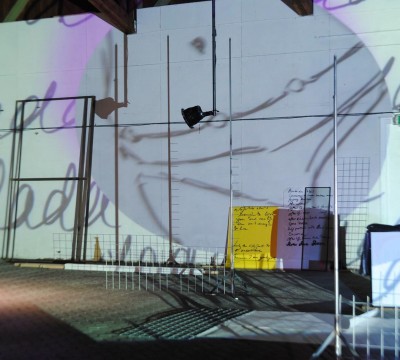wineke gartz
Wineke Gartz (Eindhoven, 1968) is best known for her drawings and multimedia installations, which she frequently composes in situ. Her installations tend to be archaic settings that consist of a complex layering of images and media, often with the use of music and multiple video and slide projections, making integral use of the architecture.
Her themes relate to beauty, death, illusion and perception, nature versus city life, art, psychology and mass media. The various parts of the work are usually displayed in such a manner that one is forced to find one’s way, as through a labyrinth.
Wineke Gartz studied at the Academie voor Beeldende Vorming in Tilburg and at the Rijksacademie Amsterdam. Her work has been displayed in, among other places, Eindhoven, Arnhem, New York, Amsterdam and Castelló (Spain).
The riddle of movement
The weekdays are the most beautiful, and especially the hour at which the cars crawl, bumper to bumper, towards the traffic lights and the petrol fumes swirl up and down the streets. Trucks are unloaded, a double-parked car causes congestion by the cash point, bicycle bells ring. This is the moment at which men and women speed their supersonic bikes to their offices on the Zuidas of Amsterdam, peddling at the top of their lungs, head on the handlebar, earplugs in, head to tail. This is the moment parents drag their children to school, stuff them into clumsy cargo bikes and: giddy-up, peddle away. It’s hard to fall over on one of these cargo bikes, so there’s no problem with checking the smartphone on the way, while the children suck their croissants.
Daily, I walk my dogs along the flank of the weekday morning rush hour in Amsterdam and I am astonished at the way in which all of that turmoil manoeuvres itself, everything passing and crossing, and how rarely anything goes wrong. I am astounded at all of those invisible lines running across streets, pavements, cycling lanes and how, in all this swarming, telephoning, whatsapping, people appear to carelessly find their way. If I had a camera and I zoomed out, would I be able to discern a pattern? Would I find a thread, a trace of bread crumbs leading to the ratio behind this tumult, the bliss, the beauty of it?
It always delights me to see the chaotically dispositioned yet highly particular work of artist Wineke Gartz (1968). I feel at home in the sketchy universes she constructs according to an extraordinary kind of logic, consisting of projections, objects, glass, steel grids, drawings, text and sound. It is as though Gartz manages to somehow capture the confusion, the exquisiteness, the loathing I experience during morning traffic, all of those different fragments brushing each other, then disappearing, in contact and yet not in contact with one another — yes, it is as though Gartz captures the riddle of all of those movements in her work.
Since Wineke Gartz left the Rijksakademie in Amsterdam in 1998, she has been exploring — as she calls it — ‘the multi-layered coexistence of images, realities and emotions.’ Her video work, to be seen at exhibitions, both nationally and internationally, comes to you in large, space filling installations, where image streams create an effect which is personal and yet possesses a quality of universal validity.
At the Noletloodsen, she has once again ripped open a universe. Dagger Smart Dagger, works with thigh is a twenty-six metre long ‘street’, which the viewer moves along. Projected onto the facades on that street — the walls of the warehouse — are video collages of office buildings, street lanterns, empty industrial estates, the occasional silhouette of a commuter. I see windows, LED lighting, there are reflections of light and colours of ads at a technical trade fair. In between, drawings pop up of hips and jewellery, hips with belly chains, jewellery around a neck. It’s beautiful, it sparkles, but all has been portrayed with a slight touch of bitterness and a certain melancholy.
What stands out are the many writings and notes by Gartz herself, which she filmed in her studio with a handheld camera. ‘Just to understand’, I read. As an incentive, as a tool to comprehend the fragmentised world. Further along, a song lyric by Ziggy Marley: ‘A lifetime isn’t enough to love you, and one lifetime isn’t enough to live. Took the risk just to understand, because I am yeah yeah.’ I recognise that lyric from one of her previous works. Especially that ‘I am yeah, yeah’ is beautiful — like erasing a sentence halfway through.
In Dagger smart Dagger, works with thigh Gartz successfully fuses the internal world of her studio with the world outside. Both are worlds of ambivalence and ambiguity. A purple circle repeatedly spins across the images like a shadow: as though I’m looking through a beautiful peephole. In front of the projections are arrangements of building materials. Oil barrels are plastered with drawings, a perfectly polished metal grate lies on the floor, a tripod features as an abstract sculpture. Many elements are recurrent: a formal, rhythmical pattern arises.
What makes Gartz’s work so good, is that it envelops you, whilst offering room for more. The work doesn’t confine itself to this twenty-six metre ‘street’. It bleeds right through the walls of the Noletloodsen, out, into the world. You need only look closely, and you’ll see it.


